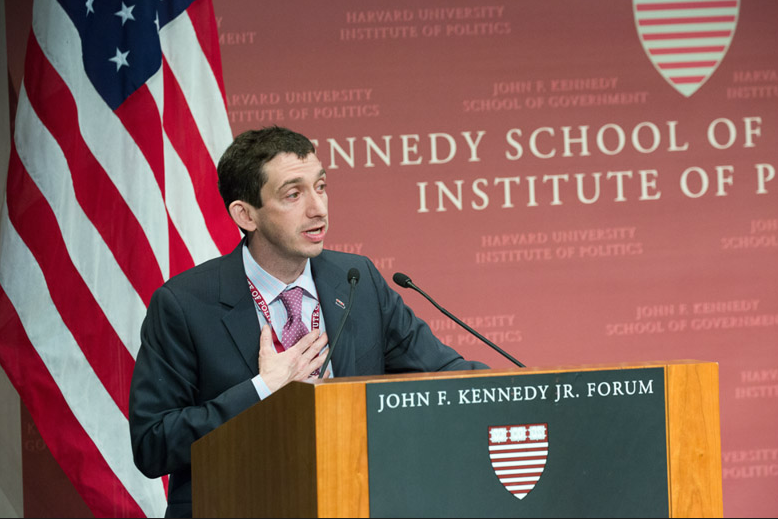Last week at the IOP’s National Campaign for Political Engagement, college students from a variety of schools around the country gathered to discuss political polarization. In one discussion group at the event, U.S. Army veteran Joe Goodwin talked with students about a proposal for a mandatory national service program. In his TED Talk, Goodwin details his vision. He pictures a world in which Americans aged 18-25 are required to spend a year serving with organizations like the Peace Corps, City Year, Teach for America, AmeriCorps, or the U.S. Military.
According to Goodwin, the national service program has a number of broad benefits. From a manpower perspective, Goodwin recognizes that more people will allow service organizations to more effectively fulfill their missions. If Teach for America has more teachers—or even more administrative assistants, it may be able to expand its services to more school districts. Additionally, he believes that the exposure to service will better equip young Americans for their future careers. It may be especially important for America’s businesspeople, politicians, and tech entrepreneurs to understand the complex problems facing underserved communities. Finally, Goodwin feels that national service can combat political divisiveness. Goodwin envisions a world in which young Americans from different political and cultural ideologies serve together, enhancing their ability to understand multiple perspectives.
While Goodwin’s goals are valuable, there are issues that must be addressed in order for his program to succeed. Students at the National Campaign offered several questions and objections to Goodwin’s proposal.
Who Will Pay for Service?
At the conference, one student asked how Goodwin would make this program accessible and affordable to all Americans. What would happen if a young person had a medical reason they needed to stay home? Goodwin believes it would be possible to find a local service opportunity in these cases, though this may be easier in theory than in reality. The student also raised concerns about how young Americans would afford this program. Goodwin responded that the government would likely provide housing and a stipend to those who participate in the program. However, this complication greatly increases the financial costs of the program. It also changes the nature of the program— the program becomes less about volunteering to serve and more about receiving a paid opportunity which the government is willing to subsidize.
Furthermore, Harvard political philosophy professor Michael Sandel argues that providing financial incentives can often corrupt or corrode moral virtues. In an Atlantic article, he writes, “Paying kids to read books might get them to read more, but might also teach them to regard reading as a chore rather than a source of intrinsic satisfaction.” It is possible that the mandatory aspect of Goodwin’s proposal would make service seem more like a chore and less like a virtue.
Who Decides What Service Means?
Another student challenged the idea that Goodwin’s proposal would decrease political divisiveness. According to this student, service itself can often create an echo chamber. Since students would be able to rank their preferred service organizations under Goodwin’s plan, it is likely that some organizations would split along ideological lines. For instance, political liberals may be more likely to do service with refugee clinics than political conservatives. Religious Americans may be more likely to do service with missionaries than nonreligious Americans.
The politicization of service brings up another challenge—which organizations get accredited? Democrats and Republicans in Congress would likely have rather different ideas regarding which organizations ought to be considered accredited. Would the American Civil Liberties Union count? What about local churches, temples, and mosques? One student asked if international organizations would be considered. Goodwin responded that he would be open to international service opportunities, however he did not delineate which ones would be acceptable. In order for Goodwin’s program to work, it would require a common definition of service—and one that appeals across party lines.
Who Can Handle All These Youngsters?
A final concern about Goodwin’s program is an economic one. His proposal rests on the assumption that service organizations would benefit from more bodies. However, he did not defend his ideas with data. It is possible that adding about 20 million Americans to the public service sector is not actually socially optimal. The opportunity cost for young Americans is a year that they could have spent on a private-sector internship, gaining research experience, or taking care of their mental health.
Overall, Goodwin’s national service idea seems appealing, though any actual implementation of the plan would be loaded with complexity. Nonetheless, even if service does not become mandatory, Goodwin is hopeful about other incentives. Young people view the core ideals of his plan sympathetically. His talk inspired a room full of college students to debate the role of service in American society. Moreover, the IOP recently reported that a majority of young people support a national service program “linked to student loan forgiveness and other relevant incentives.” Though this proposal would also need to account for the criticisms and challenges presented here, it may offer a feasible way of promoting national service.
Photo Credit: Martha Stewart/Harvard Kennedy School’s Institute of Politics.
